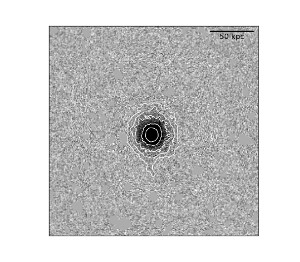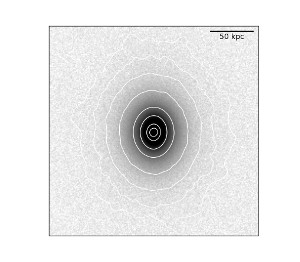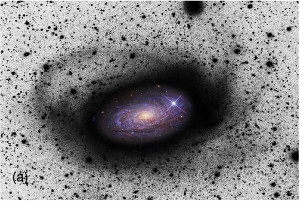|
|  |
In recent years, deep photometric observations of the local universe have
revealed that galaxies are surrounded by a "stellar halo", a group of stars
that extend to a distance of up to 100 kpc and more from the centre of the
galaxy. This stellar halo consists of field stars, older globular clusters, and
stars stripped from in-falling satellite galaxies. Too often, this stellar halo
is too faint to observe with present day imaging.
For our own galaxy, the individual stars of the stellar halo have been resolved with the help of the SDSS survey up to a distance of 50 kpc from the galactic centre. In addition, deep integrated light studies have revealed the stellar halo of neighbouring galaxies in the local universe. However, for large-scale studies of these stellar halos, many more observations are required. Unfortunately, with present telescopes and reasonable integration times, we can only detect the stellar halos of nearby galaxies.
An alternative approach to deep observations of individual galaxies would be to stack a large number of images of similar galaxies. SDSS with nearly 60,000 galaxies in its spectroscopic sample, for which accurate redshifts and stellar masses are available, is just the right survey for the job. Even though the stellar halos of individual galaxies cannot be directly observed in the photometric images, by stacking these images we can increase the signal-to-noise (S/N) ratio, and thus study the average stellar halos of the galaxies as a function of various galaxy properties.
The theory of galaxy formation through hierarchical merging predicts not only that galaxies grow in size and mass through minor mergers, but also that these minor mergers give rise to the stellar halo. This implies that the stellar halos of galaxies consist of stars which are not born in the same galaxy (in-situ stars) but rather of stars which are born in smaller galaxies that have been accreted (the accreted component).
Studying the stellar halos of galaxies gives us vital clues to further constrain the theory of galaxy formation. For example, the fraction of stellar material accreted from other galaxies is an important physical constraint in the theory of galaxy formation. In addition, the local over-densities in the stellar halo of a galaxy often contain vital clues of the accretion history of the individual galaxy, since the low density and large relaxation times of stars in the stellar halo preserves information from the distant past.
A variety of theoretical simulations have been carried out that help us to better understand the formation of stellar halos. In particular, the particle-tagging simulations done here at MPA have predicted the stellar halos of a large range of galaxies and their accreted fractions. Although the exact properties of the stellar halos of galaxies depend on the individual accretion history of a galaxy, one can predict the average stellar halo properties of galaxies as a function of the dark matter halo mass, of the stellar mass, or as a function of other properties of the galaxy.
To constrain these theories, we require observations of the stellar halos of a large number of galaxies, or alternatively stacked images as mentioned above. In this work, we have used SDSS images of galaxies in various bins of stellar mass and divided them into late-type and early-type galaxies. In each stack, we have an average of nearly 3000 galaxies. Before stacking, each image of a galaxy was transformed to a common redshift (z=0.1) and oriented along the major axis. Other galaxies and stars in the image are masked out.
The stacked images of the galaxies reveal extra light out to nearly 100 kpc (see Fig. 1) and we find that the amount of extra light in the stellar halo is a strong function of stellar mass: Larger galaxies have more extended stellar halos than smaller galaxies. Similarly, early-type galaxies have larger stellar halos than late-type galaxies. Also, the ellipticity of the stellar halo is a function of stellar mass and the haloes of early-type galaxies are more elliptical than those of late-type galaxies.
To characterize the stellar halo of the galaxy stacks in more detail, we model the two-dimensional light distribution with a ''Sersic'' profile (first published in 1963), a general mathematical function to describe the radial light intensity distribution of a wide variety of galaxy types. While this provided a good fit in the past, deviations from the Sersic profile have often been found, as deeper high-resolution data became available with newer telescopes and instruments.
For our stacked images, we find that the two-dimensional light distribution cannot be fit by a single Sersic profile, but rather needs multiple components: a double Sersic profile is needed for early-type galaxies, and a triple Sersic profile is required for late-type galaxies.
Each Sersic component traces a different physical and dynamical component of the galaxy. Under the assumption that the inner Sersic profile fits the in-situ component, and that the outer Sersic profile fits the accreted stellar component, we obtain an observational measure of the average accreted stellar light fraction of the galaxy. For early-type galaxies, the fraction of accreted stellar light rises from 30% to 70% while for late-type galaxies it is much smaller, increasing from 2% to 25% over the same mass range (See Figures 2 and 3). This provides important observational constraints for a range of galaxy masses and types, which can help differentiate between various theories of the formation of stellar halos and of the galaxies themselves.
Richard D'Souza, G. Kauffmann, J. Wang, S. Vegetti
References:
1) R. D'Souza, G. Kauffmann, J. Wang, S. Vegetti, "Parametrizing the Stellar Haloes of Galaxies",  submitted to MNRAS submitted to MNRAS
2) Cooper, A.P.; D'Souza, R.; Kauffmann, G.; "Galactic accretion and the outer structure of galaxies in the CDM model",  MNRAS, 434/4, p.3348-3367, 2013 MNRAS, 434/4, p.3348-3367, 2013
|




